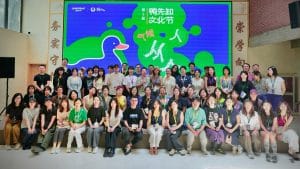In order to help improve the communication abilities of Chinese social organizations (an umbrella term that includes NGOs) on the “dual carbon” goal and other climate projects and to produce more stories on their participation in “dual carbon” related action, China Association for NGO Cooperation (CANGO) and the World Wide Fund for Nature (WWF) Beijing Representative Office launched the CN Project last year to provide funds for selected NGOs to work on climate communications.
The five NGOs selected by the CN Project last year presented their projects on July 26. The day before their presentation, they were also invited to a workshop hosted by CANGO and WWF in Beijing to exchange their ideas and discuss ways to improve their communication strategies. The workshop was also livestreamed for NGO professionals outside Beijing who are interested in the topic.
The CN Project aims to build a platform for information exchanges and communication between NGOs across the country to discuss the dissemination of climate issues because NGOs tend to focus more on projects in their day-to-day work and ignore communication, said Lin Zhenhan, communication director of WWF Beijing office.
Going into its second year, Lin said the 2023 CN Project will provide all the selected NGOs with one-on-one mentors, and hopefully the NGOs can tap their respective local communication resources and jointly build a national network.
The workshop invited Huang He, associate professor at the School of Journalism and Communication, Renmin University of China, to give a lecture on “Strategies and Paths of Climate Communications”. Huang will participate in this year’s CN Project as a mentor to some of the selected NGOs.
To figure out the goals of a communication project, according to Huang, one should start with identifying a current problem. For example, one common problem facing NGOs is that their investment in communications fails to make much impact.
The key to driving public action is that a communication project should be relevant to people, have real public benefits and be as novel as possible, Huang said. He pointed out a few effective ways to attract a larger audience, for example, giving certain environmental actions a higher symbolic value to encourage people and designing a multi-platform content strategy to reach a larger audience.
Huang suggested that organizations thoroughly identify who their target audience are before laying out their communication plans.
The suggestion is echoed by Yao Zhe, strategic communications program director of the Institute for Global Decarbonization Progress (iGDP). Yao is a co-author of the Practical Handbook for Climate Strategy Communication, which was shared with NGO professionals at the workshop.
In the Handbook, Yao emphasized the practice of designing projects with “communication consciousness”, meaning that communication activities should serve the objectives of the project rather than be considered and carried out in isolation from the project design.
In the process of project design, communication activities should not be considered in the final phase, according to the Handbook, but the role of communication should be identified at an early stage as soon as the project objectives are defined, and then the project plans and communication programs can be developed based on that.
The workshop also touched on specific examples of communication projects such as the communication process of WWF’s African elephants project, to give NGO professionals a clearer idea of how to set up their communication strategies.



